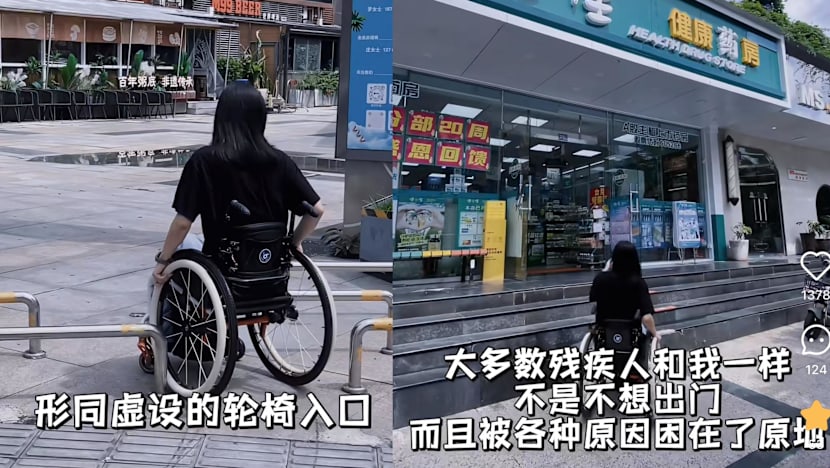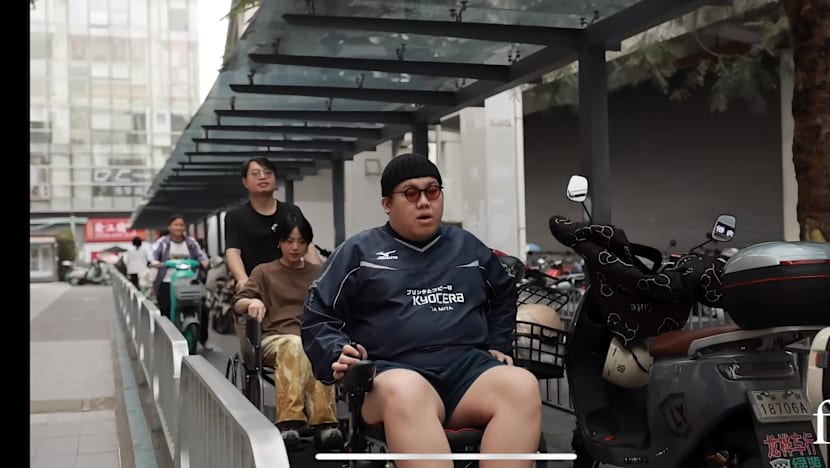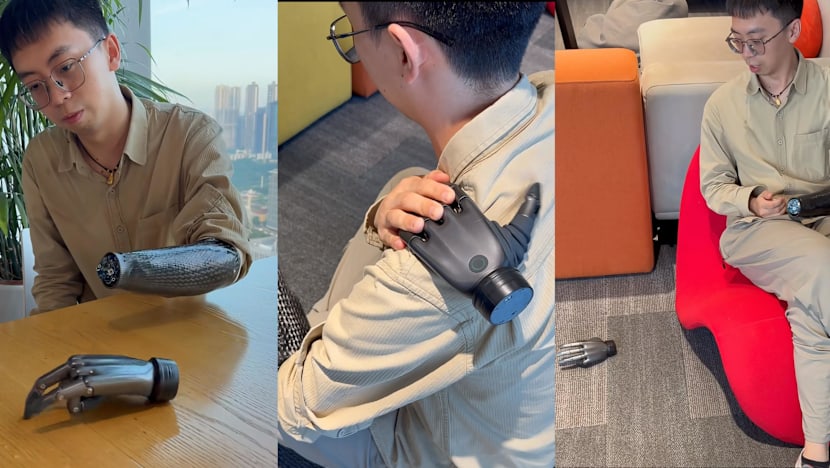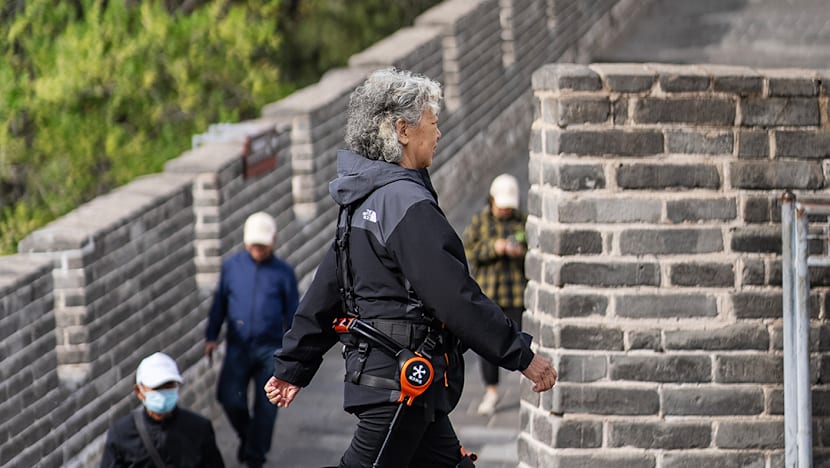Caught lying, but a singer's viral complaint still gave China's 'barrier-free' ambitions a reality check
Veteran Taiwanese singer Zheng Zhihua’s viral post about struggling to board a flight at Shenzhen Airport initially sparked a debate in China over accessibility for people with disabilities. But CCTV footage later showed airline staff assisting him onto the plane, prompting him to apologise.

Veteran Taiwanese singer Zheng Zhihua’s viral post about struggling to board a flight at Shenzhen Airport sparked nationwide debate over accessibility and empathy for people with disabilities in China. (Screenshot: Xiaohongshu)

This audio is generated by an AI tool.
SHENZHEN: The gap between the lift platform and the plane cabin door might have only been about 25cm but for Taiwanese singer Zheng Zhihua, who uses a wheelchair, it was an impassable divide.
The 64-year-old singer, paralysed from the waist down since contracting polio at the age of 2, recounted his experience on Weibo trying to board a flight to Taipei at Shenzhen Bao’an International Airport on Oct 25.
According to Zheng, the plane had been parked at a remote stand and the lift vehicle meant to help him board stopped short.
The driver “refused to raise the platform”, and “just stood there watching”, Zheng said, as he struggled to reach the doorway.
“I couldn’t stay silent in the face of such inhumanity,” Zheng wrote in a post that quickly became a trending topic on Weibo.
His words struck a chord.
Thousands of netizens shared their own stories and accounts of encountering broken lifts, missing ramps and uneven pavements - questioning how inclusive public infrastructure in China truly is for people with disabilities, the elderly and others who need physical support.
Within hours, airport officials issued an apology to Zheng, pledging to retrain staff and test new boarding ramps for passengers with limited mobility.
Yet the episode also reopened a deeper question: as China races ahead in technological innovation, can machines ever replace empathy?
Across the country, assistive technology has become a new frontier of inclusion.
From sophisticated brain-computer implants (BCI) that helped a paralysed police officer stand again, to exoskeletons aiding spinal recovery and smart prosthetics that let users play music or climb, innovation is steadily redefining accessibility.
That push is being matched by policy momentum.
In China’s upcoming 15th Five-Year Plan, both BCIs and embodied intelligence are listed among “future industries” driving the next stage of high-tech growth - also signalling a shift from research to real-world application.
These advances show how technology can make life not just easier, but possible for people with disabilities. But experts say true inclusion demands more than just innovation alone.
“A good accessibility system isn’t just functional - it’s part of a city’s art,” Zhao Wei, associate professor at Tianjin University’s Centre for Universal Design, told China Youth Magazine. “It reflects warmth, dignity and the refinement of its management.”
LIFE IN "BARRIER-FREE" CHINA
Living with a disability in China can mean vastly different experiences depending on where one lives.
For 36-year-old Yi Danli, a boutique owner in southwestern Sichuan’s Chengdu city who was paralysed after a major accident 13 years ago, even short trips can be exhausting.
For wheelchair users like her, daily life can feel like an obstacle course - from being stopped by four flights of stairs in front of a pharmacy, to getting stuck between anti-scooter barriers or manoeuvring along pavements overcrowded with parked bikes.
“Many places still fall short. There are too many steps and too few ramps or accessible toilets,” Yi said.
“Public transport also needs improvement - subways, buses, planes and high-speed trains should all be easier to use.”

Shenzhen, now in the spotlight after Zheng’s viral post, is often cited as one of China’s most innovative and inclusive cities.
It was among the first to require accessibility testing by people with disabilities before approving major urban projects.
In 2023, officials rolled out a digital accessibility map linking buses, trains, taxis and public facilities, offering real-time navigation for wheelchair users, the visually impaired and the elderly - a quiet but practical move now being emulated by other Chinese cities.
This December, Shenzhen will serve as one of the key host cities for the 12th National Games for Persons with Disabilities and the 9th Special Olympics, part of a joint event across Guangdong, Hong Kong and Macao, highlighting its ambition to become a truly “barrier-free city”.
But progress on paper often diverges from reality.
In June, a group of influencers decided to test Shenzhen’s “barrier-free” claims for themselves. Using both manual and electric wheelchairs, they filmed their journeys around the city.
Their video shared on Xiaohongshu, which garnered more than 5,000 likes and nearly 900 re-shares, showed them bumping over uneven pavements and squeezing past parked e-scooters and getting stuck at a kerb.
It ends with dry humour: “Not bad, barrier-free,” one content-creator quipped. “Barrier-free? More like limitless barriers,” another replied.

Their experiment captured the gap between official progress and lived experience, said viewers.
Luo Yan, deputy secretary-general of the China Association of Volunteers for the Disabled, told Chinese outlet Observer that she could relate to Zheng’s frustration.
A wheelchair user herself, she recalled moments when “the wheels got stuck and I almost had to move myself inch by inch into the plane”.
Such anxiety, she said, is “understandable, even for public figures”. Still, she noted that most Chinese airports “have fairly complete accessibility facilities, and when issues arise, they are usually corrected quickly once raised”.
China’s first Barrier-Free Environment Construction Law, which took effect in 2023, marked a turning point in the country’s drive to make cities more inclusive. It sets standards not only for transport and housing, but also for how people access information and digital services.
In July, the State Council Information Office announced that China had already surpassed its accessibility goals under the 14th Five-Year Plan.
More than 1.28 million homes for families with severely disabled or low-income members have been renovated, over 3,000 websites and mobile apps upgraded for accessibility, and 1,659 reading rooms for the visually impaired opened nationwide.
“The programme has helped eliminate daily household barriers, promote independent living and improve overall quality of life,” said Zhou Changkui, secretary of the Communist Party of China Leading Group of the China Disabled Persons’ Federation (CDPF) and president of its executive board, at a State Council press conference in July.
“These efforts have been welcomed by people with disabilities and their families.”
“Inclusive societies are intentional, not incidental,” Lee May Gee, chief executive of SG Enable, Singapore’s focal agency for disability inclusion, told CNA.
“Accessibility is not charity or compliance. Empathy must translate into design choices and service norms that anticipate needs rather than react to them.”
DEBATE AND BACKLASH
The discussion soon took another turn.
Days after Zheng Zhihua’s post went viral, CCTV footage began circulating online, showing airline staff assisting him onto the plane - a scene that appeared at odds with his earlier claim that he had to “crawl” inside.
The video reignited debate, with some accusing the veteran singer of exaggeration.
“Even as a disabled celebrity, he shouldn’t make things up,” one user wrote. “There’s video evidence.”
“Calling it ‘inhumane’ was too much,” another said. “Zheng went too far.”
But others came to his defence, arguing that regardless of the details, Zheng had spotlighted a long-overlooked and important issue.
“If it weren’t Zheng Zhihua, would anyone have spoken up for people with disabilities? Would we have seen such a quick response? Thank you for using your voice,” said one Weibo user.
In a follow-up post, Zheng clarified that his words were written “in frustration”. He apologised and thanked staff who had assisted him.
“Shenzhen Airport has already apologised to me personally, and I don’t intend to pursue the matter further,” Zheng said.
“I believe this was the misconduct of one lift operator, not the airport as a whole.”
He added that he hoped the incident would prompt better assistance for passengers with disabilities.
“Shenzhen is a city I love, and its people are outstanding. I hope the airport can live up to that same standard of excellence.”
Even state media weighed in. In a commentary titled Public Discussion Should Allow Imperfect Expressions, state broadcaster CCTV said that while Zheng’s choice of words had been emotional, the frustration behind them was valid and reflected wider barriers still faced by people with disabilities.
The piece urged readers not to let disputes over phrasing overshadow real problems such as boarding gaps, missing ramps and inconvenient toilets, which “undermine dignity and limit participation”.
It also praised Shenzhen Airport for its swift response and testing of new slope connectors, calling the issue “not unsolvable”.
“Progress comes when society moves beyond individual disputes and confronts shared challenges, turning public outrage into practical improvement,” the piece said.
WHEN AI GIVES A HAND
Another conversation is taking shape - one about the possibilities that technology could unlock for people with disabilities.
For Zheng Bowen, a 25-year-old entrepreneur from Zhejiang, technology is more than a tool - it is a lifeline.
Paralysed from the chest down after a fall from a five-storey height at 17, Zheng turned adversity into invention.
Drawing on his background in interior design and the Internet of Things (IoT), he opened a smart-home experience store in Hangzhou - a space where technology meets accessibility.
His goal is simple: to make intelligent home systems affordable for people with disabilities, so independence is no longer a privilege.
In his showroom, everyday life is automated. Voice commands switch on kitchen lights, toilet seats adjust at a touch, and personalised bedtime settings trigger night-mode scenes.
“Technology gives me independence,” he told CNA. “I don’t need to call someone every time I want to move around.”
Across China, that same sense of empowerment is increasingly being shaped by machines. From hospitals to homes, assistive technology is fast-moving from laboratories to living rooms.
In the northeastern city of Changchun, 35-year-old traffic officer Liu Boqi became the world’s first quadriplegic patient to regain voluntary movement through a spinal nerve-interface implant.

After a car accident last December left him paralysed from the neck down, doctors at the Second Hospital of Jilin University implanted microelectrodes in Liu’s cervical spine and paired them with an AI-assisted exoskeleton rehabilitation system.
Within months, Liu was able to stand and walk again with robotic support.
“It made me feel like I could stand and walk again. I’m full of hope for the future,” he told CCTV.
The breakthrough underscores China’s growing ambition in BCI and assistive robotics - both recognised as “future industries” in the country’s upcoming 15th Five-Year Plan.
BrainCo Inc, founded by Harvard neuroscientist Han Bicheng, has developed a non-invasive BCI that powers a mind-controlled bionic hand - enabling users to write, play the piano and even climb by decoding brain signals without surgery.
Han told Chinese media outlets that recent policies have driven “systematic progress” in funding and standards, adding that “in the long term, BCI will help people better understand themselves - reshaping rehabilitation, mental health and how we age”.

That ambition now also extends beyond hospitals. Exoskeletons are available for rent at popular mountain parks to help elderly visitors make the climb.
Earlier this year, a personal exoskeleton priced at about 2,500 yuan (US$340) sold out within 15 seconds of its launch on an e-commerce platform, signalling growing consumer appetite for affordable assistive robots.
The company behind it, RoboCT Technology, develops wearable exoskeletons for hospitals, elder-care facilities and home users.
“Policy guidance and cost control are the twin engines of adoption,” company co-founder Zhang Jiyu told CNA.
“With self-developed components and our ‘rehabilitation-as-a-service’ model, we’ve been able to lower barriers and make smart recovery tools accessible to more people.”
Zhang said the firm’s systems now serve patients with conditions like spinal injuries, stroke and cerebral palsy, as well as elderly users needing mobility support. Its exoskeletons are deployed across more than 1,000 rehabilitation and elder-care institutions nationwide.
He sees the convergence of robotics, AI and BCI as the next frontier.
“Future exoskeletons won’t just restore movement,” he said. “They’ll understand intent, adapt to users, and integrate with daily life.”

In Shenzhen’s Longgang district, Future Era, billed as the world’s first “robot 6S” showroom and service store, showcases hundreds of robots, including a dozen designed to support mobility.
“On our opening weekend alone, we saw more than 3,000 visitors, and about 60 per cent were family customers,” Lin Feng, the company’s chief executive, told CNA.
“We also had guests from the Middle East, Europe and the US, showing strong interest in functional and assistive robots.”
Lin sees the rise of AI-driven exoskeletons and intelligent prosthetics as nothing short of revolutionary.
“They help paraplegic patients stand and walk again, enable children with cerebral palsy to correct their gait, and assist the elderly in climbing stairs,” he said.
“Beyond restoring movement, they rebuild confidence, allowing people to rejoin society and live with dignity.”
TECH CAN ONLY GO SO FAR
But some experts say that as cities rush to upgrade, technology can only go so far.
“Those technologies help but will never be enough,” said Teng Kee Wee, chief executive of Singapore-based LionsForge, which runs community projects for children with special needs.
“It’s more important that all designs - from products and architecture … (to) education, be inclusive and empower people with special needs to use and navigate.”
True inclusion starts with culture and education, he added.
“True innovation comes from the heart,” he tells his students. “Only when you truly care will your innovation transform lives.”
Lee from SG Enable said the most meaningful inclusion happens when people share spaces and experiences.
“Facilities are the hardware, but it is the heartware that truly makes a difference,” she said, citing Singapore’s Enabling Village - where people with and without disabilities work, learn and play side by side.
“When accessibility stops being about accommodating some and becomes about enabling all, society becomes more humane and resilient,” she said.
“Ultimately, inclusion is not just about accessible facilities, but about the relationships we build and the mindsets we nurture. As we age, accessibility is also for our loved ones and eventually, ourselves. We all have a personal stake,” she added.



















